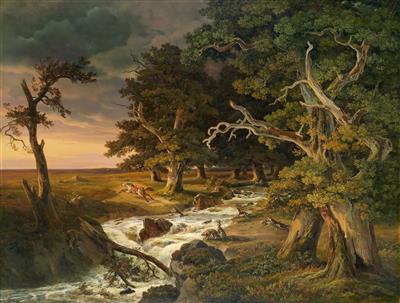Daniel Fohr

(Heidelberg 1801–1862 Baden-Baden) “Mazeppa”, signed, dated D. Fohr. Muenchen 1836, oil on canvas, 118 x 155 cm, framed, (Rei)
Catalogued in:
Friedrich von Boetticher, Malerwerke des 19. Jahrhunderts, Vol. I,1 p.332, no.4. Thieme-Becker, Künstlerlexikon, Leipzig 1924, Hofheim am Taunus, 1979, Vol. XII, p.144f.
The painter Daniel Fohr first began to study theology and then, after the glittering success of his older brother, the artist Karl Philipp Fohr, turned to painting. Particularly after his travels through Switzerland, he dedicated himself to landscape painting which he undertook in the company of Carl Rottmann and others. He went to Munich in 1829 where he studied under Peter Cornelius at the Academy and was influenced by Christian Morgenstern and Carl Rottmann. In the 1840s he moved to Baden where he was appointed court painter to the grand duke. (cf.Thieme Becker p144). “His works are distinguished by the combination of a generously proportioned depth of field and delicate use of colour and light, which can be understood as a synthesis between the late neoclassical and romanticism.“ (Saur, Allgemeines Künstlerlexikon, Leipzig 2004, Vol. 41 p. 505). The present painting, which also serves as a model for the engraving by Johann Poppel (1807-1882), is considered one of the artist’s “most important works” (Thieme Becker, p.144). The scene represented in the picture shows a legendary incident in the life of the Polish nobleman Ivan Stepanovich Mazepa, who had an affair with a married woman while he was employed in Warsaw at the court of the Polish king Johann Kasimir. When the cuckolded husband discovered the relationship, he tied the naked Mazepa backwards on an unbroken horse. It subsequently galloped away with him and he was rescued by Cossacks. Voltaire was the first to introduce this subject into Western Europe, and through Lord Byron’s epic verse of the same name it became significant as the source of inspiration for famous painters including Eugene Delacroix and Theodore Gericault.
Provenance:
From the property of a Bavarian castle, thence by descent: Anton Baron Schrenck-Notzing, royal Bavarian Court Councillor (1800–1875) and his wife Johanna, neé Lady von Asch (1809–1842); Leopold Baron Schrenck-Notzing, royal Bavarian Major, Lord of Schloss Haggn (1835–1920); Hedwig Lady von Berchem, neé Schenk Lady von Stauffenberg (1883–1944); Marilies Falck, neé Lady von Berchem (1910–2009).
Specialist: Mag. Dimitra Reimüller
 Mag. Dimitra Reimüller
Mag. Dimitra Reimüller
+43-1-515 60-355
19c.paintings@dorotheum.at
16.10.2013 - 18:00
- Realized price: **
-
EUR 32,020.-
- Estimate:
-
EUR 25,000.- to EUR 35,000.-
Daniel Fohr
(Heidelberg 1801–1862 Baden-Baden) “Mazeppa”, signed, dated D. Fohr. Muenchen 1836, oil on canvas, 118 x 155 cm, framed, (Rei)
Catalogued in:
Friedrich von Boetticher, Malerwerke des 19. Jahrhunderts, Vol. I,1 p.332, no.4. Thieme-Becker, Künstlerlexikon, Leipzig 1924, Hofheim am Taunus, 1979, Vol. XII, p.144f.
The painter Daniel Fohr first began to study theology and then, after the glittering success of his older brother, the artist Karl Philipp Fohr, turned to painting. Particularly after his travels through Switzerland, he dedicated himself to landscape painting which he undertook in the company of Carl Rottmann and others. He went to Munich in 1829 where he studied under Peter Cornelius at the Academy and was influenced by Christian Morgenstern and Carl Rottmann. In the 1840s he moved to Baden where he was appointed court painter to the grand duke. (cf.Thieme Becker p144). “His works are distinguished by the combination of a generously proportioned depth of field and delicate use of colour and light, which can be understood as a synthesis between the late neoclassical and romanticism.“ (Saur, Allgemeines Künstlerlexikon, Leipzig 2004, Vol. 41 p. 505). The present painting, which also serves as a model for the engraving by Johann Poppel (1807-1882), is considered one of the artist’s “most important works” (Thieme Becker, p.144). The scene represented in the picture shows a legendary incident in the life of the Polish nobleman Ivan Stepanovich Mazepa, who had an affair with a married woman while he was employed in Warsaw at the court of the Polish king Johann Kasimir. When the cuckolded husband discovered the relationship, he tied the naked Mazepa backwards on an unbroken horse. It subsequently galloped away with him and he was rescued by Cossacks. Voltaire was the first to introduce this subject into Western Europe, and through Lord Byron’s epic verse of the same name it became significant as the source of inspiration for famous painters including Eugene Delacroix and Theodore Gericault.
Provenance:
From the property of a Bavarian castle, thence by descent: Anton Baron Schrenck-Notzing, royal Bavarian Court Councillor (1800–1875) and his wife Johanna, neé Lady von Asch (1809–1842); Leopold Baron Schrenck-Notzing, royal Bavarian Major, Lord of Schloss Haggn (1835–1920); Hedwig Lady von Berchem, neé Schenk Lady von Stauffenberg (1883–1944); Marilies Falck, neé Lady von Berchem (1910–2009).
Specialist: Mag. Dimitra Reimüller
 Mag. Dimitra Reimüller
Mag. Dimitra Reimüller
+43-1-515 60-355
19c.paintings@dorotheum.at
|
Buyers hotline
Mon.-Fri.: 10.00am - 5.00pm
kundendienst@dorotheum.at +43 1 515 60 200 |
| Auction: | 19th Century Paintings |
| Auction type: | Saleroom auction |
| Date: | 16.10.2013 - 18:00 |
| Location: | Vienna | Palais Dorotheum |
| Exhibition: | 05.10. - 16.10.2013 |
** Purchase price incl. charges and taxes
It is not possible to turn in online buying orders anymore. The auction is in preparation or has been executed already.
